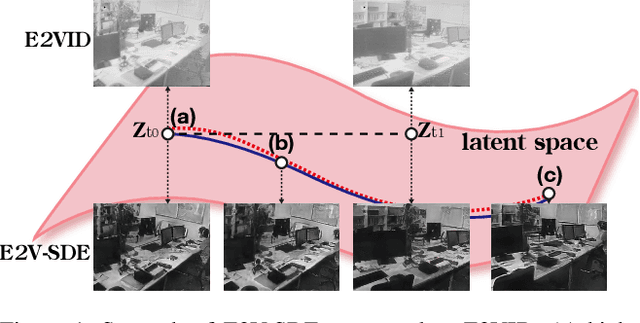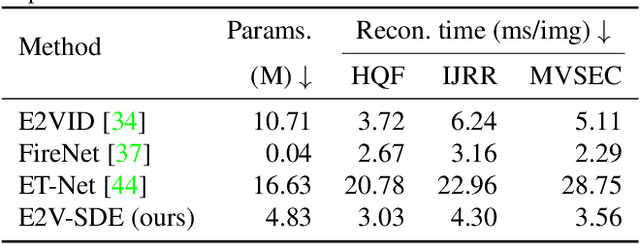Jongwan Kim
E2V-SDE: From Asynchronous Events to Fast and Continuous Video Reconstruction via Neural Stochastic Differential Equations
Jun 15, 2022



Abstract:Event cameras respond to brightness changes in the scene asynchronously and independently for every pixel. Due to the properties, these cameras have distinct features: high dynamic range (HDR), high temporal resolution, and low power consumption. However, the results of event cameras should be processed into an alternative representation for computer vision tasks. Also, they are usually noisy and cause poor performance in areas with few events. In recent years, numerous researchers have attempted to reconstruct videos from events. However, they do not provide good quality videos due to a lack of temporal information from irregular and discontinuous data. To overcome these difficulties, we introduce an E2V-SDE whose dynamics are governed in a latent space by Stochastic differential equations (SDE). Therefore, E2V-SDE can rapidly reconstruct images at arbitrary time steps and make realistic predictions on unseen data. In addition, we successfully adopted a variety of image composition techniques for improving image clarity and temporal consistency. By conducting extensive experiments on simulated and real-scene datasets, we verify that our model outperforms state-of-the-art approaches under various video reconstruction settings. In terms of image quality, the LPIPS score improves by up to 12% and the reconstruction speed is 87% higher than that of ET-Net.
* 2022 CVPR oral
Energy-efficient Knowledge Distillation for Spiking Neural Networks
Jun 14, 2021



Abstract:Spiking neural networks (SNNs) have been gaining interest as energy-efficient alternatives of conventional artificial neural networks (ANNs) due to their event-driven computation. Considering the future deployment of SNN models to constrained neuromorphic devices, many studies have applied techniques originally used for ANN model compression, such as network quantization, pruning, and knowledge distillation, to SNNs. Among them, existing works on knowledge distillation reported accuracy improvements of student SNN model. However, analysis on energy efficiency, which is also an important feature of SNN, was absent. In this paper, we thoroughly analyze the performance of the distilled SNN model in terms of accuracy and energy efficiency. In the process, we observe a substantial increase in the number of spikes, leading to energy inefficiency, when using the conventional knowledge distillation methods. Based on this analysis, to achieve energy efficiency, we propose a novel knowledge distillation method with heterogeneous temperature parameters. We evaluate our method on two different datasets and show that the resulting SNN student satisfies both accuracy improvement and reduction of the number of spikes. On MNIST dataset, our proposed student SNN achieves up to 0.09% higher accuracy and produces 65% less spikes compared to the student SNN trained with conventional knowledge distillation method. We also compare the results with other SNN compression techniques and training methods.
 Add to Chrome
Add to Chrome Add to Firefox
Add to Firefox Add to Edge
Add to Edge